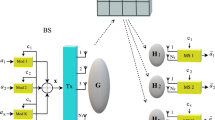Abstract
Massive multiple-input and multiple-output systems combined with hybrid beamforming technique is a key approach to achieve high data rate and extended cell coverage in the fifth generation (5G) cellular networks . Specifically, the precoding for analog/digital hybrid beamforming technique is absolutely essential for millimeter-wave (mm-wave) frequency based transmission for 5G, simply because the technique reduces hardware complexity and energy consumption for high-frequency design. In order to prove the aforementioned advantages, the present paper will investigate the energy efficiency (EE) and optimization of low complexity hybrid precoding (EELCHP) algorithm to enable the reduction of radio frequency (RF) chains within the base station (BS). The proposed solution will also incorporate high-resolution phase shifters (HRPS) specifically for downlink multi-user mm-wave system. The intelligence within the EELCHP algorithm for hybrid beamforming is based on the fully complex zero-forcing (ZF) precoding mechanism that allowed the maximization of energy efficiency by reducing the RF chains, without affecting the potentially increasing number of antennas. In addition, maximum EE is possible by eliminating the nonlinear concave fractional issue based on the Lagrange duality method. During the simulation process of the proposed method, we further realized that hardware complexity and power consumption can be reduced by allowing the RF chains to select only one beam per switch within the beamforming solution. Furthermore, with the implementation of EELCHP algorithm, more energy is saved due to low complexity system by reducing the required RF chain.




Similar content being viewed by others
References
Rangan, S., Rappaport, T. S., & Erkip, E. (2014). Millimeter-wave cellular wireless networks: Potentials and challenges. Proceedings of the IEEE, 102(3), 366–385.
Rusek, F., Persson, D., Lau, B. K., Larsson, E. G., et al. (2013). Scaling up MIMO: Opportunities and challenges with very large arrays. IEEE Signal Processing Magazine, 30(1), 40–60.
Lee, C. S., & Chung, W. H. (2017). Hybrid RF-baseband precoding for cooperative multiuser massive MIMO systems with limited RF chains. IEEE Transactions on Communications, 65(4), 1575–1589.
Alkhateeb, A., Leus, G., & Heath, R. W. (2015). Limited feedback hybrid precoding for multi-user millimeter wave systems. IEEE Transactions on Wireless Communications, 14(1), 6481–6494.
Song, N., Yang, T., & Sun, H. (2017). Overlapped subarray based hybrid beamforming for millimeter wave multiuser massive MIMO. IEEE Signal Processing Letters, 24(5), 550–554.
Han, S., Chih-Lin, I., Xu, Z., & Rowell, C. (2015). Large-scale antenna systems with hybrid analog and digital beamforming for millimeter wave 5G. IEEE Communications Magazine, 53(1), 186–194.
Gao, X., Dai, L., Sun, Y., Han, S., et al. (2017). Machine learning inspired energy-efficient hybrid precoding for mmWave massive MIMO systems. In IEEE international conference on communication (ICC), Paris, France (pp. 1-6).
Zi, R., Ge, X., Thompson, J., Wang, C. X., et al. (2016). Energy efficiency optimization of 5G radio frequency chain systems. IEEE Journal on Selected Areas in Communications, 34(4), 758–771.
Hao, W., Zeng, M., Chu, Z., & Yang, S. (2017). Energy-efficient power allocation in millimeter wave massive MIMO with non-orthogonal multiple access. IEEE Wireless Communications Letters, 6(6), 782–785.
Garcia-Rodriguez, A., Venkateswaran, V., Rulikowski, P., & Masouros, C. (2016). Hybrid analog–digital precoding revisited under realistic RF modeling. IEEE Wireless Communications Letters, 5(5), 528–531.
Sayeed, A., Brady, J. (2013). Beamspace MIMO for high-dimensional multiuser communication at millimeter-wave frequencies. In Proceedings of the IEEE GLOBECOM, Atlanta, GA, USA (pp. 3679–3684).
Ngo, H. Q., Larsson, E. G., & Marzetta, T. L. (2013). Energy and spectral efficiency of very large multiuser MIMO systems. IEEE Transactions on Communications, 61(4), 1436–1449.
Liang, L., Xu, W., & Dong, X. (2014). Low-complexity hybrid precoding in massive multiuser MIMO systems. IEEE Wireless Communications Letters, 3(6), 653–656.
Marzetta, T. L. (2010). Noncooperative cellular wireless with unlimited numbers of base station antennas. IEEE Transactions on Wireless Communications, 9(11), 3590–3600.
Isabona, J., & Srivastava, V. M. (2017). Downlink massive MIMO systems: Achievable sum rates and energy efficiency perspective for future 5G systems. Wireless Personal Communications, 2(96), 2779–2796.
Boyd, S., & Vandenberghe, L. (2004). Convex optimization. Cambridge: Cambridge University Press.
Alonzo, M., Buzzi, S., Zappone, A., D’Elia. C. (2019). Energy-efficient power control in cell-free and user-centric massive MIMO at millimeter wave. In IEEE transactions on green communications and networking (pp. 1–13).
Zhu, L., Zhang, J., Xiao, Z., Cao, X., Wu, D. O., & Xia, X. G. (2019). Joint Tx-Rx beamforming and power allocation for 5G millimeter-wave non-orthogonal multiple access (MmWave-NOMA) networks. IEEE Transactions on Communications, 67, 5114–5125.
Acknowledgements
The authors would like to thank the Ministry of Higher Education, Malaysia, under the Fundamental Research Grant Scheme (FRGS) (V.1627), FRGS (V. K190), and TIER1 (V.H243).
Author information
Authors and Affiliations
Corresponding author
Additional information
Publisher's Note
Springer Nature remains neutral with regard to jurisdictional claims in published maps and institutional affiliations.
Rights and permissions
About this article
Cite this article
Salh, A., Audah, L., Mohd Shah, N.S. et al. Energy-Efficient Power Allocation with Hybrid Beamforming for Millimetre-Wave 5G Massive MIMO System. Wireless Pers Commun 115, 43–59 (2020). https://doi.org/10.1007/s11277-020-07559-w
Published:
Issue Date:
DOI: https://doi.org/10.1007/s11277-020-07559-w




